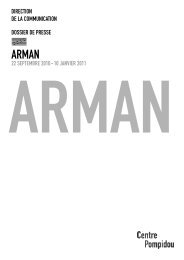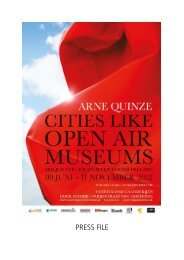Arman - Vicky David Gallery
Arman - Vicky David Gallery
Arman - Vicky David Gallery
Create successful ePaper yourself
Turn your PDF publications into a flip-book with our unique Google optimized e-Paper software.
13<br />
cocktail of materials and kitsch motifs associated with an intervention intended as non-art, these first<br />
Cachets of 1954 testify to an absolutely fundamental advance, anticipating the debate that some years<br />
later would see Clement Greenberg – with his theory of high culture and low culture, conceiving kitsch<br />
as a degraded form of expression, expelled to the margins of culture – opposed by younger critics such<br />
as Lawrence Alloway or Barbara Rose, who defended the rising generation of Neo-Dada and Pop artists.<br />
For <strong>Arman</strong>, these first Cachets served as the first foundations of an approach that, in the late 1950s, after<br />
the Gait of Objects phase, would define itself as resolutely postmodern. 6<br />
Between 1955 and 1960, <strong>Arman</strong> was simultaneously seeking his own personal artistic path and a strategy<br />
that would win him a name and respite from financial difficulties. Should he settle in Nice or in Paris?<br />
Before New York proved to be the answer, which would be the better gallerist: Iris Clert, Jean Fournier,<br />
D’Arquian or Jean Larcade? Before George Marci and Sidney Janis turned up, before Larry Rubin opened<br />
up the American market to <strong>Arman</strong>, what networks, what schools of thought should he attach himself to?<br />
Art critic Pierre Restany, or Pierre Schaeffer, inventor of concrete music? And if the picture is to be<br />
complete, one shouldn’t leave out Claude Rivière, a journalist with Combat who would support <strong>Arman</strong> in<br />
his endeavours, or Yves Klein, to whom <strong>Arman</strong> was so close that their artistic procedures can sometimes<br />
seem to have emerged from the same conceptual mould. For tactical reasons, Pierre Restany would<br />
always tend to analytically disentangle – and so in my opinion over-clarify – these two inextricably entangled<br />
approaches.<br />
Pierre Restany came to art criticism through the “informal” abstraction that emerged in 1947 with Dubuffet<br />
and Fautrier, challenging the geometric abstraction of the post-war period, held to be cold and analytical,<br />
and championing in its stead an art based on pure spontaneity. The almost undisputed intellectual leaders<br />
in the field were Michel Tapié, famous for having introduced the American abstract expressionists to<br />
France, who would end up working with the René Drouin gallery, and Charles Estienne, who would convince<br />
André Breton of the existence of an abstract surrealism, thus prompting the opening of the gallery<br />
À l’Étoile scellée. In the narrow world of the informal, it wasn’t easy for Restany to find a place of his own,<br />
but he quickly developed a powerful, international network of connections, among them Jean-Pierre<br />
Wilhem in Dusseldorf and Guido Le Noci in Milan. In 1956, Restany joined the editorial committee of the<br />
journal Cimaise, alongside Michel Ragon. Restany never sought to deny the fascination that Yves Klein<br />
exerted over him from their very first meeting. From then on, he invested all his energy into promoting<br />
the latter’s work, and through his friendship with Klein, <strong>Arman</strong> too benefited by association, exhibiting<br />
in most of the galleries that showed his friend. Restany at first classified Hains, Tinguely and even Villeglé<br />
under the label of the Informal, notably on the occasion of the first Paris Biennale in 1959. 7 In his Lyrisme<br />
et abstraction (1958), an argument for what he himself had baptized lyrical abstraction, 8 he evoked<br />
in connection with the pictorial spatiality created by gesture a new and different spatiality generated<br />
by the deployment of new materials by those whom two years later he would marshal under the banner<br />
of the New Realism, one of whom was <strong>Arman</strong>. Among the reasons for his own shift of interest from the<br />
Informal to the New Realism, Restany would identify his disillusion in the face of lyrical abstraction’s<br />
inadequacy to a new social context, when after the post-War reconstruction French society was hurtling<br />
into the three-decade long industrial expansion that would be known as the Trente glorieuses. Lyrical<br />
abstraction had been an art of escape: the New Realism – the phrase itself a verbal riposte to Socialist<br />
Realism – would metaphorically reflect the power of consumer society. A signatory to the October 1960<br />
manifesto, <strong>Arman</strong> would take Restany’s side against Yves Klein’s challenge to his authority at the time<br />
of the exhibition “À 40° au-dessus de dada” in 1961. By the autumn of 1963, however, he had passed over<br />
to the critics, seeking “de-restanyfication,” admitting as if to an adultery his invitation to the critic Alain<br />
Jouffroy to write the catalogue essay for his exhibition at the Schwarz gallery. “The experience has been<br />
positive on the whole,” he wrote to Restany, “the New Realism is no longer discussed or disputed, it is and<br />
will continue to be an influence. There’s only one thing I still hanker for: to see what is next and if possible<br />
to play a part in it. In the classification of painterly tribes, I believe I belong more among the nomadic<br />
than the sedentary”. 9 <strong>Arman</strong> clearly felt that he had his own, personal future before him. New Realism<br />
may indeed have been an integral element of his strategy at the beginning of the decade, but the artist<br />
now settled in the United States had a more expansive vision of territorial conquest under his own steam.<br />
In one of his letters to Eliane, written in 1959, <strong>Arman</strong> comments as follows on a large Cachet: “it is a bit<br />
less rubber-stamp than the others and a bit more […] concrete pictorial proposition”. 10 Around now,<br />
following from his commitment to the Socratic maieutic, <strong>Arman</strong> produced very large format compositions<br />
that began to gain a favourable critical reception and also his very first artistic earnings. The terminology<br />
of “concrete pictorial propositions” that <strong>Arman</strong> employs is directly borrowed from the discussion of<br />
concrete music around Pierre Schaeffer, founder of the Groupe de Recherches Musicales (GRM). <strong>Arman</strong><br />
and Éliane Radigue had been in contact with Schaeffer since 1957. If <strong>Arman</strong> was already referring to this




